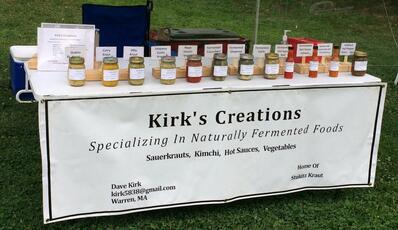 The Amherst Farmers’ Market welcomes back Kirk’s Creations. First joining the market in 2017, David Kirk introduced his family’s recipes for lacto-fermented deliciousness. The list of lactic acid fermented foods is long. kimchi, sauerkraut, and dill pickles; several styles of hot sauces and chile pastes; cultured dairy products like yogurt, crème fraîche, and cheese; kombucha, salami, and, yes, even sourdough bread. To quote Sandor Katz, in The Art of Fermentation, “I have searched—without success—for examples of cultures that do not incorporate any form of [lactic acid] fermentation. Indeed, ferments are central features of many, perhaps even most, cuisines.” Lacto-fermentation experienced a resurgence during the height of COVID - hello to everyone who tried a sourdough starter - it’s far from a new trend. It’s been around for over 10,000 years and there isn't a culinary culture on the planet that doesn't present evidence of lacto-fermentation. Civilizations have been controlling fermentation for thousands of years, with some of the earliest examples being fermented beverages. A fermentation of fruit, honey, and rice discovered in Neolithic China dates back to 7000 BC. In the Caucus, wine-making dates to around 6000 BC. People were fermenting beverages in Babylon around 3000 BC. Even thousands of years before fermented alcoholic beverages were developed, fermentation was occurring with a food known for notoriously poor holding qualities – dairy. The milk of camels, goats, sheep, and cattle was naturally fermented as far back as 10,000 BCE. It’s likely the fermentation spontaneously occurred, due to naturally microflora present in the milk. The climate where this dairy fermentation took place played a large role in its occurrence, as lactic acid fermentation favors the heat of this climate. The first yogurts were produced in goat bags draped over the backs of camels in the heat of North Africa, where temperatures around 110°F made ideal conditions for fermentation to occur. It wasn’t until the mid 1800s, though, that people understood what was happening to make their food ferment. In 1856, Louis Pasteur connected yeast to the process of fermentation, making him the first zymologist – studying the applied science of fermentation. He defined fermentation as, “respiration without air”. Fermentation was still being used solely to increase the holding and storing properties of food. It wasn’t until 1910 that fermented foods were first considered as beneficial to health. Leo F. Rettger of Yale concluded in 1935 that certain strains of Lactobacillus acidophilus could survive the environment of the human gut and were necessary for optimal digestion. In the last 50 years, extensive research has been conducted examining the health benefits of consuming friendly bacteria. There appear to be linkages between consuming foods containing these bacteria and improved digestion, among other areas. The popularity of “probiotic” products reflect this knowledge. Probiotics are a food/beverage that contains friendly bacteria. Products labeled with this word are all over stores – everything from yogurts to dietary supplements. Fermented foods, as Pasteur determined, are naturally high in these friendly bacteria. Let’s return to 1900 for a moment, though, and forget about the possible health benefits derived from eating fermented foods. In 1900, fermentation was a method of food preservation. Fermenting foods provided a way to store them without the need for refrigeration. While farm wives in 1900 may not have been making kimchi or kombucha, they were certainly feeding their families fermented foods such as cheese, bread, beer, and vinegar. Without giving you a full-on microbiology lesson, the basic principles of food preservation by fermentation depend on the transformative action of microbes and the manipulation of environments to encourage the action of certain desired microbes and discourage the presence or action of less desirable microbes. Fermentation is an anaerobic process, which means it occurs in an airless environment. The desirable bacteria thrive in this oxygen-free environment digesting sugars, starches, and carbohydrates and releasing alcohols, carbon dioxide, and organic acids (which are what preserve the food). The undesirable bacteria that cause spoilage, rotting, and decay of food can’t survive in this anaerobic environment
0 Comments
 Hello, I’m David Drugan, owner / operator of the Buzz-Off Bee Company. I am a ‘sideline’ beekeeper who manages approximately 55 hives on local farms in multiple locations in Westfield, Agawam, West Springfield, and Southampton. I began keeping bees approximately eight years ago after working with a now retired beekeeper who is a family friend. This now retired beekeeper had learned that I successfully removed an enormous wasp nest (of all things) from my home, and invited me to come along and assist him remove a feral honey bee colony which had taken-up residence within a barn in Belchertown. After successfully rehousing the feral colony, he gifted me the bees and equipment (my first hive), and I was hooked! Stung a few times as well during the removal, but that comes with the territory. Later that year, the one rehoused barn honey bee colony morphed into three hives and my backyard was alive with activity. Those three hives grew to six hives in year two, and six hives grew to twelve hives in year three… and with a local demand for smaller-scale pollination (and a wife who was questioning just how many bees in the backyard was enough - that's the nice version), my backyard hobby has developed into a fantastic opportunity to work with local farmers by providing pollination support to their fields / crops, while learning about their farms. And as you may have guessed, the hive count still continues to grow each year. The byproduct of an expanding hive count, and now working with multiple local farms and farmers, are all the products of the honey bee hive, including hundreds of pounds of raw honey, raw honey comb, wax, and pollen. Although you can see all of the products of the honey bee hive on my vendor table, the real star of the display has to be the single-frame observation hive which is alive with activity. The observation hive allows for people of all ages a quick glimpse into the inner-workings of a honey bee colony, while asking questions about what is going on ‘under the glass’. Finding the queen is usually on the mind of most visitors, but it’s great to be able to offer some educational opportunities about honey bees, listen to bee-related stories, and offer insight to local raw honey and products. Becoming a vendor at the Amherst Farmers' Market this year has been absolutely terrific. The ability to provide a local raw honey product to our community is truly only one of the great parts of participating in the Amherst Farmers Market. The fantastic questions and answer opportunities which I engage in with passersby is the real highlight of the day - meaningful questions about honey bees, including: why is the honey different colors, how much wax is produced from a colony, and countless others offers a bit of bee related information even if it's just a quick glance from afar. Be sure to stop over at the table, ask a question or two, and perhaps share a bee related story. Trust me, if there’s one thing I can, and like to do (like every beekeeper) - it’s talk bees! 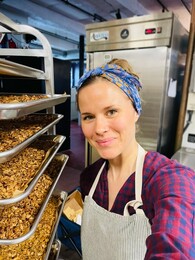 Sweet Babu’s is a small batch bakery currently offering handmade granolas in a variety of flavors. Our granola is uniquely twice baked at low temperatures, giving it delicious caramelization and crunchy clusters. It is gluten-free, dairy-free, soy-free, and has no additives or preservatives – no weird stuff. You will recognize every ingredient in our recipes. You may even recognize where they’re from! Because our granola is handmade in small batches it won’t lose that homemade flavor. Sweet Babu’s supports local farms and small businesses like ourselves. We use local honey and local maple syrup as sweeteners and buy our oats locally as well. We value knowing where our ingredients are sourced from and how they impact our community. That’s why, weekly we’re at the Amherst Farmer’s Market, to be a part of the community alongside other local business that support each other. The products are great but it’s the vendors and customers that make the Amherst Farmer’s Market what it is. I’ve lived in the pioneer valley my whole life and it feels really special to now offer a product that is bringing happiness to many people in and around town. Just ask where to find the granola lady! Our company may grow but our granola will always be small-batch, twice baked, and made with much love.  We are Joyce and Ken Douthwright, a long-time married couple, from Belchertown, MA. We spent our lives working in stressful careers and raising a family. We always dreamed of enjoying a relaxing retirement, traveling and exploring the country and the world, just enjoying our simple carefree lives. Boy, did we ever get that wrong! Since retiring in 2017, we have been busier than ever! Instead of that lovely, relaxed lifestyle we so coveted, we found something unexpected waiting for us. We now get to spend our weekdays taking care of our two precious granddaughters, Lyla and Haley. And do they keep us hopping! When we’re not busy with them, we’re busy creating beautiful soaps and skin care products, and running a small business. So how did we get here? Many, many moons ago, Joyce bought her first piece of handmade goat milk soap. It was a simple bar, but it was amazing. The lather was great, her skin felt nourished and moisturized, and she thought, “I’ll bet I could make this.” And so it began. She dug into researching how to make cold process soap, watching hours and hours of YouTube videos, reading blog posts, trying out more than a few recipes she found online, and fell in love with the process. It’s been quite a journey from making very basic soaps with other people’s recipes, to formulating her own recipes, and experimenting with color, design, and technique. Within a few years there was so much soap that there was no way the family could ever use it all, and so began the business. It’s interesting to look back on the process and see all the twists and turns this journey has taken. At first it was just a craft fair here and there, then the Belchertown Farmers and Artisans Market, the Winter Market in Hadley, her own website, and now the Amherst Farmers Market. As we’ve expanded our customer base and Ken has joined in the creative process, we’ve also added on many new products. In addition to all the soaps Joyce makes, we’re also making our own shampoos, hair conditioners, body butters and lotions, lip balms, bath bombs, sugar scrubs, and cedar soap decks. All of this has required copious amounts of research, experimentation, formulating and reformulating recipes, and lots of trial and error. We are passionate about putting out great products, tweaking and refining our recipes until we have created a product we not only love using ourselves, but that we’re proud to put our name on. The quality of ingredients in each of our products is key, as is utilizing locally sourced ingredients as much as possible. All of our goat milk is locally sourced from a small farm right here in Belchertown, the beeswax in our lip balms is sourced from a family friend who has their own apiary, and the honey in our Oatmeal Milk and Honey soap is from a local beekeeper just down the street from us. We’re so proud of what we have accomplished in the last few years and even more proud of the products we put out. We are passionate about using the best ingredients, creating high quality products, and giving great customer service. We love meeting our customers in person and getting to know them on a more personal level. We are so excited to be a part of the Amherst Farmers Market and are looking forward to getting to share our products with you!  By Contributing AFM Writer; Cheryl Conklin As a parent, you play a key role in the health and wellness of your children. But one day, your kids are going to venture out on their own and assume responsibility for their own habits and choices. Set them up for success by instilling healthy habits from a young age! Teach them how to navigate difficult decisions and make choices that will benefit their mental and physical wellbeing in the long run. Below, you’ll find several great resources to help you do just that! Make Healthy Habits Part of Your Routine Research shows that habits form when we do the same things over and over again. Establish a healthy routine for your family and help your kids develop good habits!
Set a Good Example for Your Kids Kids don’t just learn what you tell them, but they pick up on your actions as well. Let your children watch you making healthy choices.
Teach Healthy Coping Behaviors Children who learn healthy ways to cope with negative emotions are less likely to experiment with drugs and alcohol when they grow up.
Teaching your child to enjoy healthy habits from a young age will set them up for a long and happy life. By setting a good example for your little ones, teaching positive coping behaviors, and establishing healthy family routines, your kids will develop the skills they need to make healthy choices for years to come! 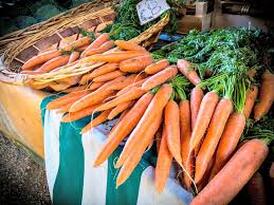 By Contributing Writer; Aimee Whittington Ph.D. Growing evidence shows that farmers’ markets reduce food insecurity, and thus risk of hunger. They do so by generating social capital, promoting healthy food utilization and consumption, and increasing healthy food access in target communities. Additionally, many markets are recognizing a growing role in anti-hunger work. Definitions of food security vary but the most widely accepted definition is “a situation that exists when all people, at all times, have physical, social, and economic access to sufficient, safe, and nutritious food that meets their dietary needs and food preferences for an active and healthy life”. (Food and Agriculture Organization of the United Nations) Partnerships between nonprofit area food banks and local farmers’ markets provide opportunities to distribute the maximum social and nutritional benefits of farmers’ markets. Traditionally and still too often, an experience afforded overwhelmingly to middle- and high-income consumers. Aligning farmers’ markets with food banks generates opportunities for markets to serve low-income customers and fight hunger where it begins. Building social capital in a community has become increasingly important, with the evolution of social media. Broadly defined, social capital is “the value of social networks, bonding similar people and bridging between diverse people, with norms of reciprocity”. With regard to fighting hunger, social capital is central to food security. More of the former leads to greater chance of the latter. Social safety nets/supports and connected communities increase household resilience to economic and environmental stressors. While social exclusion or deprivation greatly increase rates of food insecurity. Surveys of farmers’ markets show that social interaction and community-building are important reasons for attendance, on the part of both customers and vendors. Farmers’ markets empower food insecure customers to consume healthy food, via formal and informal education programs and incentives. Markets provide a setting for community members to gain the knowledge, confidence, and desire required to choose and prepare a variety of (often unfamiliar/region-specific) fruits and vegetables. When asked, market visitors overwhelmingly report positively affected attitudes towards ‘healthy food’ consumption. And studies show well over 50% of regur farmers’ market patrons report eating more fruits and vegetables because of their attendance. By incorporating educational materials, markets working with nonprofits that target low income consumers, can assist customer learning and positively affect the attitudes towards healthy food choices. In addition to changing customer attitudes, farmers’ markets can increase access to nutritious food. Strategic placements of markets in locations frequented by target populations can increase geographic access to healthy food. By partnering with local food banks, farmers’ markets provide access to products normally inaccessible to food bank patrons. Based on national SNAP and WIC enrollment, farmers’ markets are not convenient to low-income community members. Over half of the people using a federal benefit had to travel over 30 minutes to reach the market, with half of those having to utilize public transport. Partnerships between farmers’ markets and food banks work especially well because of the food bank itself, which hosts many low-income clients. The influence of farmers’ markets in general, and those in Massachusetts with respect to the Healthy Incentives Program in particular, on economic access to food is quite clear. By encouraging all vendors to accept SNAP, WIC, and WIC and Senior FMNP food assistance, markets increase the number of food insecure and/or low-income customers who have access to healthy food. Markets at which eligible vendors accept food assistance benefits have, overwhelmingly and for ALL transaction types - higher sales. Additionally, SNAP and matching incentive programs have brought new customers and new revenue to markets across the country. Depending on the city, between 25-60% of new market customers surveyed cited them as a reason for attending. When farmers’ markets generate income and influence market forces at vendors’ booths and beyond, they can increase their community’s overall economic and food security. The “social atmosphere” of farmers’ markets encourages small business and entrepreneurial growth, in addition to developing business management skills in growing enterprises. They can be used to build supportive social networks, while promoting a strong local economy, creating income for small producer. Not only does aligning farmers’ markets with local nonprofit food banks create opportunities for low-income communities to combat food insecurity, it also cultivates small business growth, as a return on investment to community. 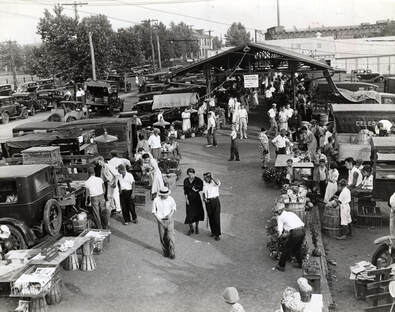 By Contributing Writer; Aimee Whittington Ph.D. Farmers’ markets have a long and multi-faceted history, existing in one form or another for over 5,000 years. Originating in Egypt, the farmers growing in the fertile Nile River Valley came together to sell their products. Unlike modern American farmers’ markets, which are usually held weekly, Egyptian markets took place daily. Each city had a centralized market, selling not only food but supplies and crafts, as well. Some of the products would have looked quite different, such as barley, flax and live animals but the framework is the same. Interestingly, ancient Egyptian markets operated on a trade or barter basis, as the people did not use money. Customers brought finished homemade items made from market goods to barter for necessary supplies. Most exchanges were based on the deben (roughly 3 ounces), an Egyptian unit of measurement. Purchases were placed on one side of a scale and debens added to the other until the scale balanced. This process helped keep trading fair. Massachusetts boasts the first recorded farmers’ market in the United States. Held in Boston, it opened in 1634. appeared in Boston in 1634. 9 other New England markets were up and running by 1700. As the colonies and their cities expanded, so did the need for a consistent supply of foodstuffs and other products. It makes sense farmers’ markets have a presence extending so far back in history. Before the transportation and refrigeration of goods became accessible, communities were far more intertwined with surrounding farmlands. Growth in the urban areas resulted in concomitant growth in agriculture. As cities began to grow into areas previously used for agriculture, farmlands were pushed farther and farther away from the communities they served. Simultaneously, technological advances in storage and transportation opened up opportunities for farms to move even farther out. Grocery stores became an increasingly popular source for produce and goods as early as the 1700’s. In the most densely populated urban areas, farmers’ markets began to disappear and interests shifted to these stores, which offered more of both choice and convenience. Unfortunately, better roads and sustainable refrigeration soon ushered in the spread of supermarkets and wholesalers in all areas of the country, not just the cities. Many small farms and markets were cut out of the food cycle. Shortly after WWII ended, there were only 6 markets in the entire state of California. Luckily, the 1960s and 70s saw an America which was becoming more health-conscious. With a cultural shift away from mass production and mass consumption, farmers’ markets began to appear again. Fresh, healthy, and easy-to-prepare foods became more of a priority for families. And nostalgia played a factor, as the public remembered the quaintness of farmers’ markets, their sense of community and the access to fresh foods they provided. Farmers’ markets experienced explosive growth between 1994-2008. While that growth has definitely leveled off, there are 8500+ markets in the U.S. and $1.1 billion dollars is spent at them annually. A billion dollar business where the practices are a net positive for everyone involved. 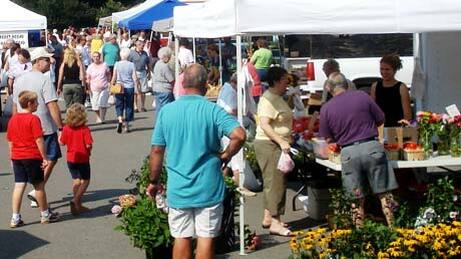 By Contributing Writer; Aimee Whittington Ph.D. After the last 2 market seasons, it’s become even more apparent that the Amherst Farmers’ Market is more than simply a place to purchase food. For many, it was the only (or one of a very few) opportunity they had to interact with other people. So as the 2022 season rapidly approaches for the AFM, we’re looking at continuing to strengthen the market’s engagement with the local community. One of the most common ways farmers’ markets engage is through consumer education. A chef’s stage or other live cooking event, guided market tours and cross promotion strategies between vendors are all tools which can draw customers in, while also providing knowledge and agency for the shopper. As the public becomes increasingly interested in local food, education provides a double win because it both draws in customers and equips them with new knowledge to combat food insecurity. Social media is another tool markets can use to foster community engagement, especially among younger consumers. Using it for advertising and education is an efficient way to reach a larger number of people. Postings include a mix of short and long form articles, videos, recipes and local news stories. Special events can be important for bringing markets greater exposure and bring new customers. Additionally, these events have been cited as a way to attract low income customers who often feel like a farmers’ market is an exclusive place. They present no obligation to spend money and offer something fun for young children. Monthly “festivals” and events based around a specific product - tomato time, for example - are by far the most popular approaches taken by markets. A once a month special event strikes a balance where it’s regular enough customers will remember it takes place but not so often the event doesn’t feel special. For instance, with tomato time, a market might do a tomato tasting and provide recipes and nutritional information. Lastly, kid’s activities and engagement can attract younger people, making them familiar and comfortable in the market. Which is important because in 10 years, those children will be the household grocery shoppers. Additionally, the more entertained the children of customers are, the longer the shopping experience will take. This is another double win for the vendors and the community. The longer people stay, the more they tend to purchase but also, hopefully, the more opportunities the Amherst Farmers’ Market has to continue strengthening the community. With only 3 months before the first 2022 AFM, the market staff is very much looking forward to finding new ways to strengthen the bonds with customers we have and forge new ones with customers we don’t have, yet. Building on the momentum of the last 2 difficult but very successful seasons, we look forward to making it the 51st season even better. 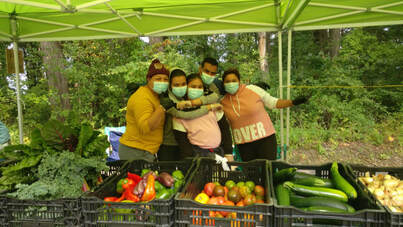 By Contributing Writer; Aimee Whittington Ph.D. A "food desert" is defined as a geographic area where access to affordable, healthy food options - especially fresh fruits and vegetables- is restricted or nonexistent due to the absence of grocery stores within easy traveling distance. According to a report prepared for by the Economic Research Service of the USDA, about 19 million people in the US reside in a food desert, with 2.5 million of them residing in Massachusetts. In urban areas, access to public transportation can help residents overcome the difficulties posed by distance, but economic forces have driven grocery stores out of many cities in recent years, making them few and far between and an individual’s food shopping trip may require taking several buses or trains. In suburban and rural areas, public transportation is either very limited or unavailable, with supermarkets often many miles away from people’s homes. The other defining characteristic of food deserts is socio-economic: that is, they are most commonly found in BIPOC communities and low-income areas, where many people don’t have cars. Studies have found that wealthy districts have three times as many supermarkets as poor ones do, that white neighborhoods contain an average of four times as many supermarkets as predominantly black ones do, and that grocery stores in African-American communities are smaller with less selection. People’s choices about what to eat are severely limited by the options available to them and what they can afford—and many food deserts contain an overabundance of fast food chains selling cheap “meat” and dairy-based foods that are high in fat, sugar and salt. Processed foods (such as snack cakes, chips and soda) typically sold by corner delis, convenience stores and liquor stores are usually just as unhealthy. Communities that are located in food deserts are often overlooked when relying on data collected by the US government. Part of the problem is how the US government’s Industry Classification System categorizes retail outlets that sell food. According to the NAICS code, small corner grocery stores are statistically lumped together with supermarkets, such as Safeway, Whole Foods Market, etc. In other words, a community with no supermarket and two corner grocery stores that offer liquor and food would be counted as having two retail food outlets even though the food offered may be extremely limited and consist mainly of junk food. Those living in food deserts may also find it difficult to locate foods that are culturally appropriate for them, and dietary restrictions, such as lactose intolerance, gluten allergies, etc., also limit the food choices of those who do not have access to larger chain stores that have more selection. Additionally, studies have found that urban residents who purchase groceries at small neighborhood stores pay between 3 and 37 percent more than suburbanites buying the same products at supermarkets. To address this problem locally, many communities have started mobile farmers’ markets. The Amherst Mobile Market was started in the summer of 2020. It makes affordable produce available within walking distance of residents who would otherwise struggle to access healthy food. Additionally, it allows low income and BIPOC community members to retain agency over their decision making. Challenges around food access in Amherst are always extant for some but most people don’t know nearly all of Amherst's census tracts are designated as food deserts by the USDA. Residents without vehicles represent 11% of Amherst's population and it can take over two hours to get to and from the grocery store by bus. Over 2 dozen residents, all residing in food deserts, participated in the planning process and the market employed 14 Amherst residents in 202 and 2021. There are over a dozen local small farms participating and for $5 a week, customers get a 6 item ‘farmshare’. The cost of which is reimbursable through the Healthy Incentives Program, if the SNAP benefit is used. Food insecurity and food deserts are two very real problems facing far too many people today. Fortunately, through continued innovations of programs like the Healthy Incentives Program and the Amherst Mobile Market, and LOCAL outlets like the Amherst Farmers' Market, it’s one that’s being addressed. 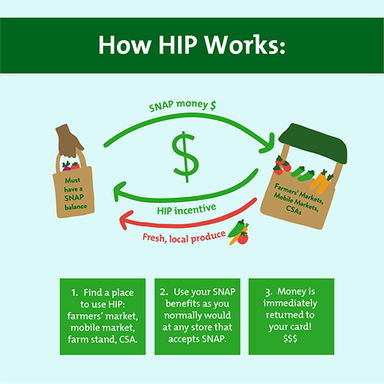 By AFM Contributing Writer; Aimee Whittington, Ph.D. With respect to the Amherst Farmers’ Market, one positive development to come out of the last 2 years is the increased diversity of the market’s customer base. Not only did the pandemic bring out a much younger demographic, as seen by the large number of college students shopping from 10 a.m. until breakdown, it also sparked a resurgence in overall community interest in direct to consumer food sales. Additionally, the market saw an increased usage of one of the nation’s most innovative programs designed to address food insecurity and healthy food access - the Healthy Incentives Program (HIP). HIP is a program administered by the Massachusetts Department of Transitional Assistance and funded through a combination of federal funds, state funds and private contributions. For market customers who are enrolled in the Supplemental Nutritional Assistance Program (SNAP - formerly known as food stamps), HIP ‘rewards’ recipients with extra benefits when they use SNAP to purchase fruits, vegetables, and certain plants at farmers markets, farm stands, CSAs. HIP is the first program of its kind established in the U.S. Depending on household size, Massachusetts’ HIP funds match SNAP benefits dollar-for-dollar: By using HIP, SNAP recipients can earn back up to: ● $40 monthly (for 1 – 2 people) ● $60 monthly (for 3 -5 people) ● $80 monthly (for 6+ people) Massachusetts has historically done groundbreaking work, with regards to local and direct marketed agriculture and food insecurity. In 2006, The Food Project’s Lynn Central Square Farmers’ Market became one of the first in the country to accept SNAP benefits electronically/They also piloted a small SNAP matching program. Two years later, this small program served as a model for the Boston Bounty Bucks program, a dollar-for-dollar matching program for use at Boston-area farmers’ markets. This program demonstrated the demand generated by SNAP-matching for consumers and expanded the opportunity for Massachusetts farmers to sell their harvests locally. These two programs served as the precursor and inspiration for the Healthy Incentives Program, which launched statewide in 2017. In that first year, HIP helped over 36,000 families gain access to farm-fresh produce. By 2019, that number had grown to 19,000 households per month utilizing the benefit. For individual recipients, HIP is only a positive. It increases access to fresh, local produce and helps stretch SNAP dollars without extra paperwork. It rewards recipients for buying local produce at designated locations. Lastly, it allows SNAP recipients to grow their own fruits and vegetables, if they choose, by purchasing food-producing plants and seeds. It’s also a boon to local producers. For the state economy, HIP has provided Massachusetts farmers with more than $15 million in revenue. It has served to broaden the customer base for many small, local farms struggling to increase revenue and continues to do so. Most importantly, HIP has allowed access to products which were historically too expensive for customers on a restricted budget. Everyone should be able to feel the juice of a peach on their chin or smell the ‘summer’ of a tomato as they slice it. HIP is allowing people to do just that. |
AFM Marketblog
Bringing you organic, grass-fed, pasture-raised, locally-sourced blog posts on a semi-weekly basis from the Amherst Farmers' Market. Archives
July 2022
categories...
All
|
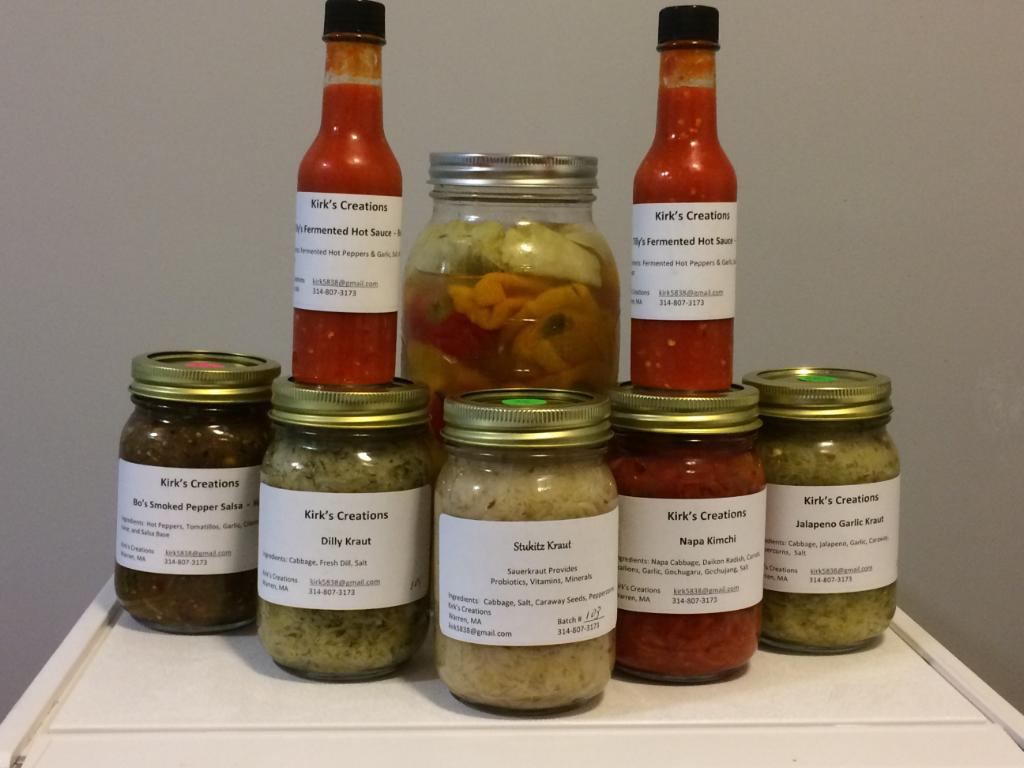


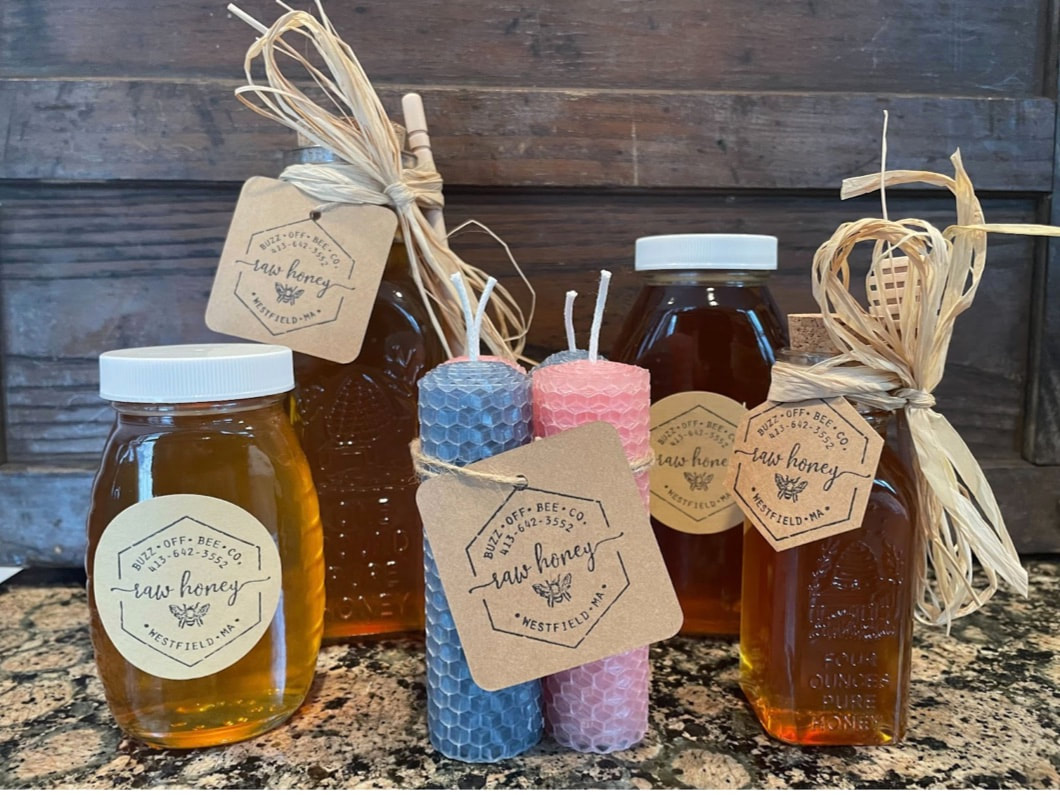

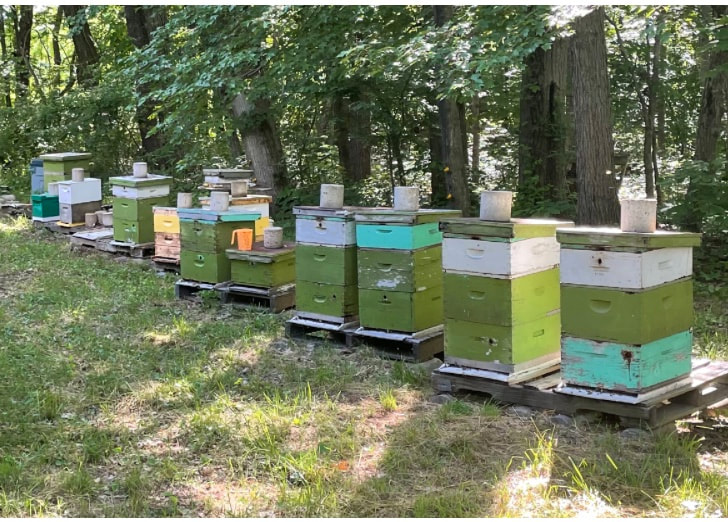


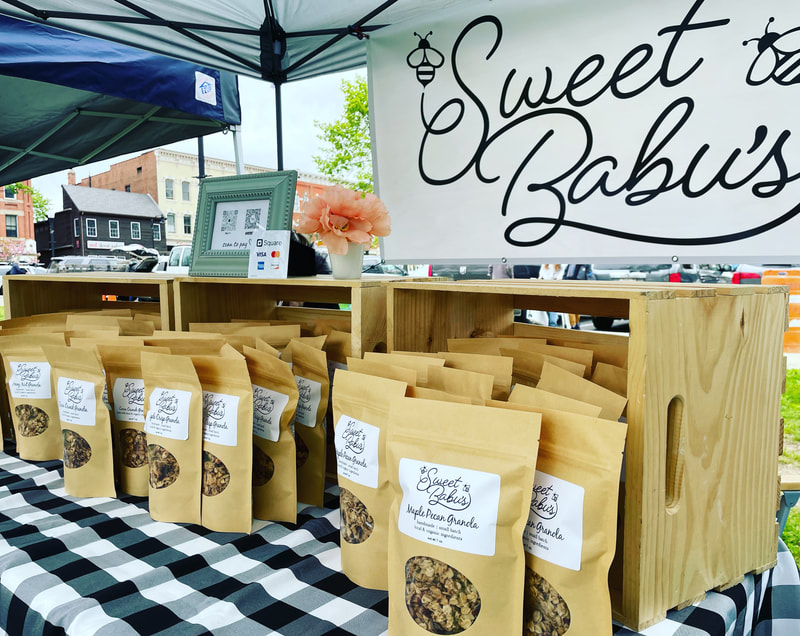
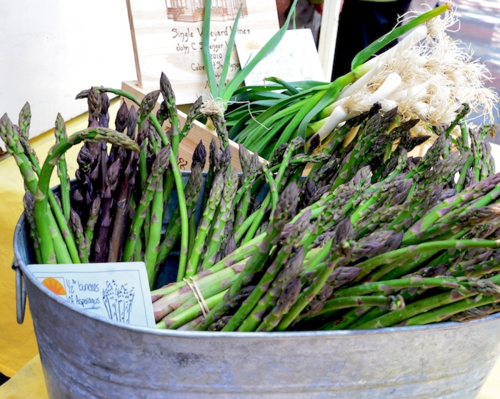

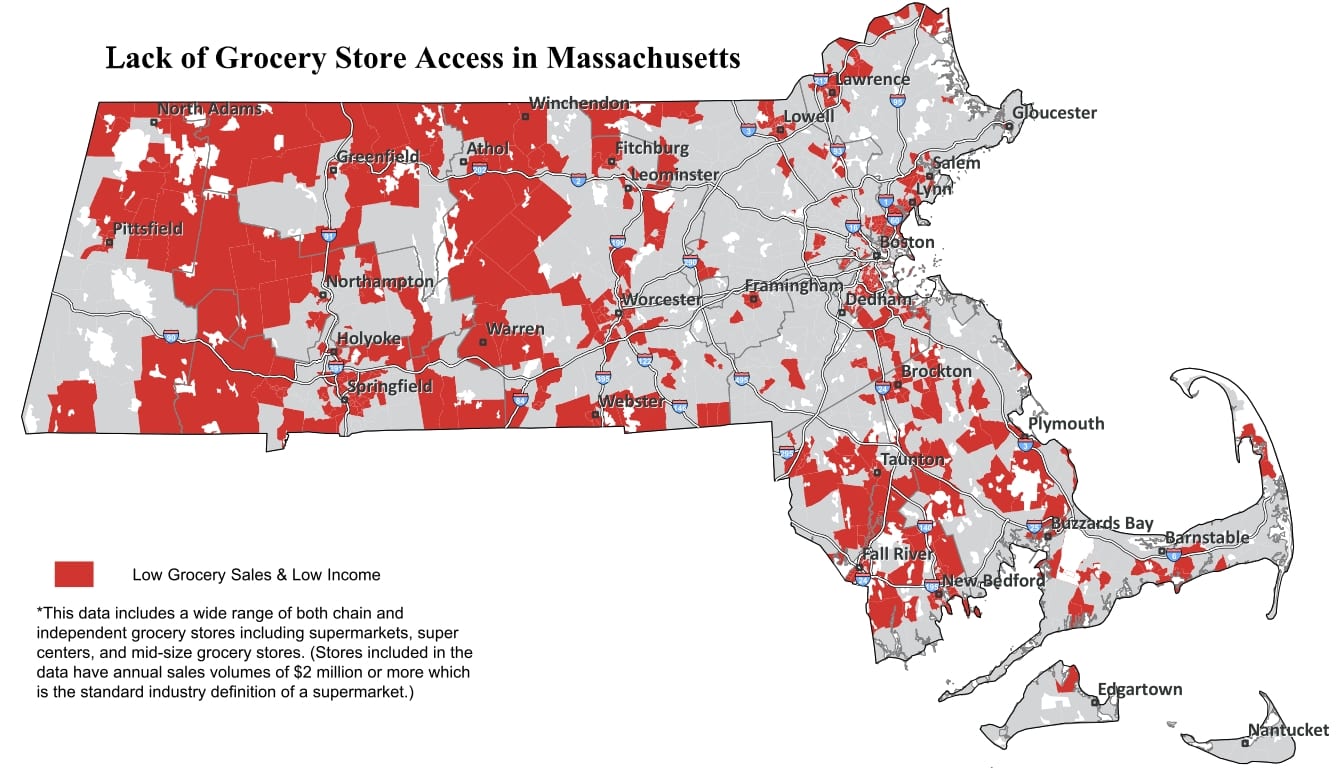
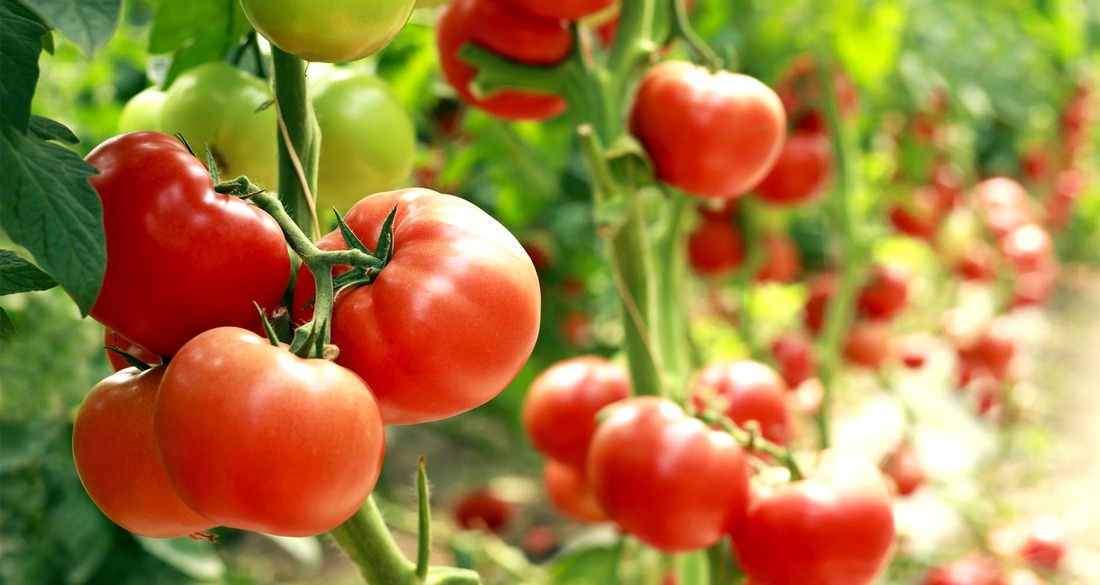
 RSS Feed
RSS Feed
